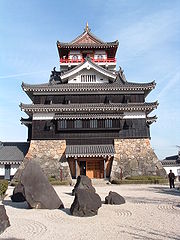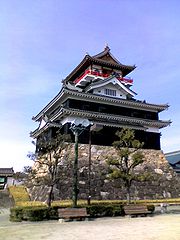
Kiyosu Castle
Encyclopedia


Oda Nobunaga
was the initiator of the unification of Japan under the shogunate in the late 16th century, which ruled Japan until the Meiji Restoration in 1868. He was also a major daimyo during the Sengoku period of Japanese history. His opus was continued, completed and finalized by his successors Toyotomi...
during the latter half of the Sengoku period
Sengoku period
The or Warring States period in Japanese history was a time of social upheaval, political intrigue, and nearly constant military conflict that lasted roughly from the middle of the 15th century to the beginning of the 17th century. The name "Sengoku" was adopted by Japanese historians in reference...
of feudal Japan. It is located in the city of Kiyosu
Kiyosu, Aichi
was a town located in Nishikasugai District, Aichi, Japan., the town had an estimated population of 19,409 and a density of 3,696.95 persons per km²...
, Aichi Prefecture
Aichi Prefecture
is a prefecture of Japan located in the Chūbu region. The region of Aichi is also known as the Tōkai region. The capital is Nagoya. It is the focus of the Chūkyō Metropolitan Area.- History :...
, Japan
Japan
Japan is an island nation in East Asia. Located in the Pacific Ocean, it lies to the east of the Sea of Japan, China, North Korea, South Korea and Russia, stretching from the Sea of Okhotsk in the north to the East China Sea and Taiwan in the south...
.
The current partial reconstruction dates to 1989 and was built as a centennial celebration for the modern-day city of Kiyosu.
Castle history
Kiyosu Castle was built between 1394 and 1427, first belonging to Shiba Yoshishige, then head of the Shiba clanShiba clan
The was a Japanese clan claiming descent from the Minamoto clan of the Heian era that held influence and territory in the provinces of Echizen province and Owari province to which they were governors during the Sengoku era. However, they were unable to make a transition to Sengoku-daimyo and lost...
and the shugo
Shugo
was a title, commonly translated as "Governor," given to certain officials in feudal Japan. They were each appointed by the shogun to oversee one or more of the provinces of Japan...
(governor) of Owari Province
Owari Province
was an old province of Japan that is now the western half of present day Aichi Prefecture, including much of modern Nagoya. Its abbreviation is Bishū .-History:The province was created in 646....
. Upon completion of construction, Oda Toshisada was installed in the castle as the shugodai
Shugodai
were officials during feudal Japan.Shugodai were representatives of provincial shugo when the shugo could not exercise his power, being often away from his province. Unlike shugo, who were appointed from the central power, shugodai were locally appointed....
(vice-governor of the province). It is thought to have been intended as a defensive stronghold meant to protect Orizu Castle, the seat of Owari's provincial government until its destruction during battle in 1476. After the loss of Orizu Castle, the government shifted to Kiyosu, bringing prosperity to the city.
Operating from Nagoya Castle
Nagoya Castle
is a Japanese castle located in Nagoya, central Japan. During the Edo period, Nagoya Castle was the center of one of the most important castle towns in Japan—Nagoya-juku— and it included the most important stops along the Minoji, which linked the Tōkaidō with the Nakasendō.-History:In...
, Oda Nobunaga
Oda Nobunaga
was the initiator of the unification of Japan under the shogunate in the late 16th century, which ruled Japan until the Meiji Restoration in 1868. He was also a major daimyo during the Sengoku period of Japanese history. His opus was continued, completed and finalized by his successors Toyotomi...
captured Kiyosu Castle in 1555. After Nobunaga's death, his second son, Nobukatsu
Oda Nobukatsu
was a Japanese samurai of the Azuchi-Momoyama period. He was the second son of Oda Nobunaga. He survived the decline of the Oda clan from political prominence, becoming a daimyo in the early Edo period.-Kitabatake clan:...
, came into control of the castle and began large scale renovations in 1586.
Deconstruction
In 1610, the capital of Owari was moved from Kiyosu to nearby Nagoya on the orders of Tokugawa IeyasuTokugawa Ieyasu
was the founder and first shogun of the Tokugawa shogunate of Japan , which ruled from the Battle of Sekigahara in 1600 until the Meiji Restoration in 1868. Ieyasu seized power in 1600, received appointment as shogun in 1603, abdicated from office in 1605, but...
. Once a thriving castle town
Castle town
A castle town is a settlement built adjacent to or surrounding a castle. Castle towns are common in Medieval Europe. Good example include small towns like Alnwick and Arundel, which are still dominated by their castles...
of 60,000 people, much of the city disappeared in what is known as the "Moving of Kiyosu."
Parts of Nagoya Castle were constructed with the use of building materials taken from Kiyosu Castle. Constructed using parts taken from the Kiyosu Castle tower, one of the names of the northwest turret of Nagoya Castle's Ofukemaru fortress is subsequently the "Kiyosu Turret."
Use of Kiyosu Castle would continue until the Edo period
Edo period
The , or , is a division of Japanese history which was ruled by the shoguns of the Tokugawa family, running from 1603 to 1868. The political entity of this period was the Tokugawa shogunate....
of the 18th century. Tokugawa Yoshinobu
Tokugawa Yoshinobu
was the 15th and last shogun of the Tokugawa shogunate of Japan. He was part of a movement which aimed to reform the aging shogunate, but was ultimately unsuccessful...
, a descendant of Tokugawa Ieyasu, was the last owner of the castle.
The original kinshachi (金鯱) are now in Sōfuku-ji
Sofuku-ji (Gifu)
' is a Buddhist temple located in Gifu, Gifu Prefecture, Japan. The temple has strong ties to both Saitō Dōsan and Oda Nobunaga. Gifu's Sōfuku-ji is famed throughout Japan for both the number of monks it produces and for its "Blood Ceiling". Shortly after its founding, it was also known as Kōsai-ji...
in Gifu
Gifu, Gifu
is a city located in the south-central portion of Gifu Prefecture, Japan, and serves as the prefectural capital. The city has played an important role in Japan's history because of its location in the middle of the country. During the Sengoku period, various warlords, including Oda Nobunaga, used...
in the neighboring Gifu Prefecture
Gifu Prefecture
is a prefecture located in the Chūbu region of central Japan. Its capital is the city of Gifu.Located in the center of Japan, it has long played an important part as the crossroads of Japan, connecting the east to the west through such routes as the Nakasendō...
.

